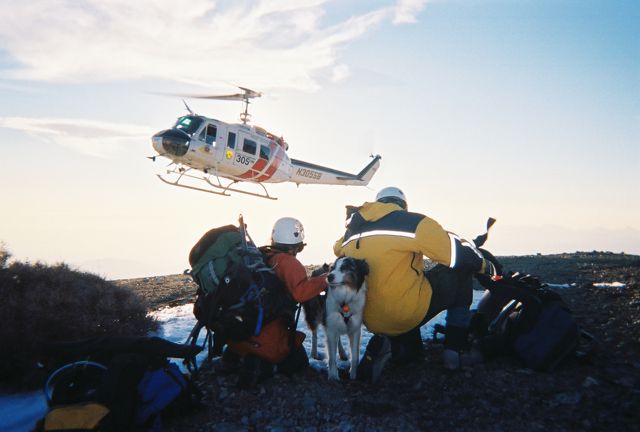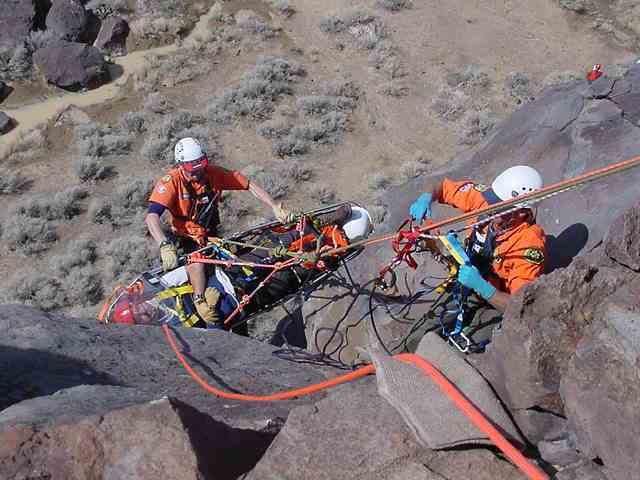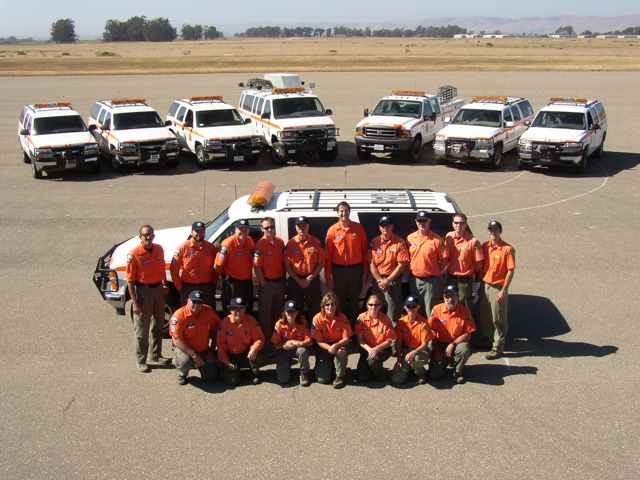Summer of Search and Rescue
Recent Spike in Trail Incidents a Cause for Concern

The 911 call from a 22-year-old stranded on the backside of Cathedral Peak came in about 8:30 p.m. this past Tuesday evening, August 24. “I’m okay,” the lost hiker explained, “but I’ve lost the trail and it’s too dark now to find my way back down to Inspiration Point.”
Within minutes, Santa Barbara County Search and Rescue personnel were on the road and the Sheriff’s Aviation Bureau in the air. Using night vision gear, Sheriff’s Copter 2 spotted the hiker off-trail in a saddle located about 700 feet below La Cumbre Peak, and then quickly guided the SAR field team down to him. After a brief medical check and a few sips of water, he was then led back up to La Cumbre Peak just a few hours after he’d called for help.
Though the operation was over quickly and led to the safe rescue of the hiker, it highlighted a growing problem: Search and rescue operations in Santa Barbara County are on the rise, especially on the front country trails. “Calls are 10-15 percent above normal this year,” said Nelson Trichler, SAR incident commander for the Cathedral Peak operation. “That’s not a huge spike, but a lot of these have been on the trails immediately behind Santa Barbara.”

Over the past two months, SAR teams have been called out on eight separate occasions to deal with emergency situations in the Santa Ynez Mountains. These range from a dehydrated trail runner near Divide Peak in the mountains behind Carpinteria, to sprained knees and a broken ankle near Inspiration Point, to a variety of incidents involving hikers heading off the main trails to spots such as Seven Falls, Tangerine Falls, or Cathedral Peak. One rescue even involved a stretcher carryout of an 80-pound dog from the upper part of Cold Spring Canyon where it had injured its leg while playing on a slab of wet sandstone.
A recent article in the New York Times suggested the uptick in rescues can be directly attributed to the rise in the use of technology, especially smart phones and personal locator beacons such as the SPOT, which allows users to send personalized messages out to friends or even send out an SOS call to an emergency response center requesting immediate assistance. Just two weeks ago a SPOT call-in was received from South Fork Station deep in the heart of the San Rafael Wilderness. When SAR personnel arrived on the scene they discovered a San Luis Obispo man who’d had a seizure and fallen, injuring his neck. Though the injury wasn’t life threatening, without use of the SPOT technology the situation might have become much worse.
“The biggest change we’ve seen in the past few years in terms of call-outs,” said Trichler, “is the use of cell phones.” Trichler estimated that three-fourths of the calls for assistance now come via cell phones, either from the victim or someone else on the trail reporting in. “The mentality seems to be, if something happens, I’ll just call 911 and let the rescue people deal with it,” Trichler added. “It’s like there’s a feeling that there is this huge safety net out there to help out if trouble occurs.”
But while use of cell phones may be leading to an increased number of calls, there are benefits as well. “We’re also getting called out sooner when things start to go wrong,” Trichler explained. “Before cell phone coverage was so extensive, more often than not, if someone got injured the only option would have been a self-rescue. Now we are getting to people before an even more serious situation develops.”

One example Trichler cited was of an ATV rider who went off the edge of a road near Little Pine Mountain and was stuck for more than 24 hours before he was discovered. With a cell phone in hand the rider could have called in to 911, or, with a SPOT, notified emergency personnel of the situation immediately. Fortunately he was spotted by fire crews responding to a vegetation fire.
But while the “911 cell phone rescue mentality” may be responsible for an increase in the number of Search and Rescue call-outs, the biggest issue may be the proximity of our urban community to the Santa Ynez Mountains. “People don’t realize that we live on the edge of wild country,” Trichler continued. “It’s not a walk in the park. You’ll have someone who starts out for a short hike, then continues on a bit further, or decides to explore a side creek or off-trail route, and before you know it, sunset is approaching and they’re stuck.”
A good example of this was the hiker rescued from Cathedral Peak last week. Starting from his home near Stevens Park, his destination was Inspiration Point. But when he got there he spotted one of the off-trail routes heading up toward Cathedral Peak and decided to continue on up it. After reaching the first high point, Arlington Peak, he decided he might be able to continue on past Cathedral to La Cumbre Peak and head back down from there. “At each point along the way, he decided he could go a little further,” said Trichler, “until finally he realized he’d lost the trail and didn’t have time to go back the way he’d come. He had plenty of water and snacks, a space blanket for shelter, and seemed well prepared, but on the other hand he’d gotten all the way to this point wearing flip-flops.”
One of the things that also may be at play is the rise of social networking sites like Facebook or MySpace. “We have a huge number of City College and UCSB students, as well as tourists, who really don’t have much familiarity with our local trails,” Trichler added, “but they’ll see pictures of a great viewpoint or waterfall that a friend has posted online and decide they want to go see them without a clue where they are or how difficult it will be to get to them.”
The message that the Santa Barbara County Search and Rescue would like to emphasize is that there is no substitute for being as prepared as possible when heading out on the trail. “Having plenty of water and enough food is important,” said Trichler. “Wearing the proper type of shoes to help prevent leg and ankle injuries is also important, as is having a good map with you to help familiarize yourself with your surroundings.” Most important may be to learn to develop what trail experts call “situational awareness,” which includes thinking about what might go wrong and what you can do to prevent that from happening.



